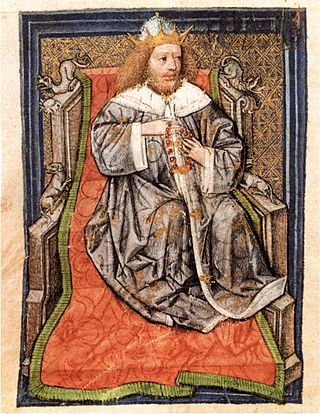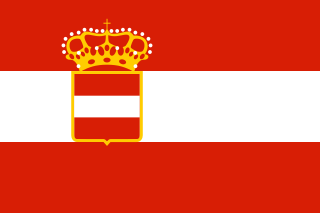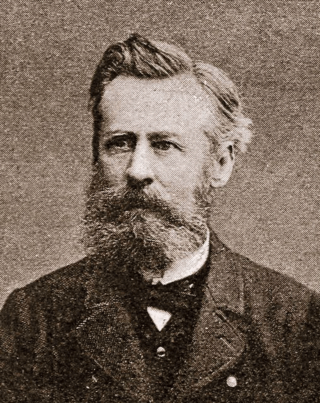
Albert VI, a member of the House of Habsburg, was Duke of Austria from 1424, elevated to Archduke in 1453. As a scion of the Leopoldian line, he ruled over the Inner Austrian duchies of Styria, Carinthia and Carniola from 1424, from 1457 also over the Archduchy of Austria until his death, rivalling with his elder brother Emperor Frederick III. According to tradition, Albert, later known as the Prodigal, was the exact opposite of Frederick: energetic and inclined to thoughtlessness.
Ludwig Merwart was an influential Austrian painter and graphic artist. He is an important representative of Tachism and was a major force in graphic arts and prints, especially after World War II. His work belongs to the most significant and interesting contributions to graphic arts in Austria to this day.
The Wittgenstein Award is an Austrian science award supporting the notion that "scientists should be guaranteed the greatest possible freedom and flexibility in the performance of their research." The prize money of up to 1.5 million euro make it the most highly endowed science award of Austria, money that is tied to research activities within the five years following the award. The Wittgenstein-Preis is named after the philosopher Ludwig Wittgenstein and is conferred once per year by the Austrian Science Fund on behalf of the Austrian Ministry for Science.

Friedrich Stadler is an Austrian historian and philosopher and professor for history and philosophy of science at the University of Vienna. He is the founder and long-time director of the Institute Vienna Circle, which was established as a Department of the Faculty of Philosophy and Education of the Vienna University in May 2011. Currently he is a permanent fellow of this department and serves at the same time as the Director of the co-operating Vienna Circle Society, which is the continuation of the former Institute Vienna Circle as an extra-university institution.

The Common Army as it was officially designated by the Imperial and Royal Military Administration, was the largest part of the Austro-Hungarian land forces from 1867 to 1914, the other two elements being the Imperial-Royal Landwehr and the Royal Hungarian Honvéd. However, it was simply known as the Army (Heer) by the Emperor and in peacetime laws, and, after 1918, colloquially called the k.u.k. Armee.

The Supreme Commander of the Imperial and Royal Armed Forces was the ultimate authority of the Austro-Hungarian Armed Forces – which comprised the Army, Navy and Aviation Troops of Austria-Hungary.
Franz Rauscher, born in Vienna, Austria, was an Austrian Social Democrat politician.

Oswald Redlich was an Austrian historian and archivist, known for contributions made in the field of auxiliary sciences of history.

Franz Krones Ritter von Marchland was an Austrian historian.

Géza Pálffy is a Hungarian historian, full (university) professor. He has long been active in research of the relationship between the Habsburg monarchy and Kingdom of Hungary in the 16–17th centuries. He works as a scientist both in Hungary and around the world, and has published in several languages: English, German, Slovak, Croatian, Romanian, French, Russian, Italian, Czech, Turkish and Hungarian.
Christian Rapp is an Austrian author, cultural scientist and exhibition curator.
Christa Ehrmann-Hämmerle is a Swiss-born Austrian historian. She is Associate Professor of Modern History at the University of Vienna. Her work focuses on military history, particularly World War 1, as well as women and gender history of the 19th and 20th centuries. Since 2011, she has been a spokeswoman for the Military History Working Group. She is co-founder and co-editor of the scientific journal L'Homme - Europäische Zeitschrift für Feministische Geschichtswissenschaft.
Felix Czeike was an Austrian historian and popular educator. He was an author and partly also editor of numerous publications on the history of Vienna and was the director of the Wiener Stadt- und Landesarchiv. His main work is the six-volume Historische Lexikon Wien.

The Battle of Herkulesfürdő was a military engagement during the Romanian Campaign of World War I. It was fought between Romanian forces on one side and Central Powers forces on the other side. It resulted in a Romanian victory.
The First Battle of Orsova was a World War I military engagement between Austro-Hungarian and German forces on one side and Romanian forces on the other side. The Central Powers failed to advance, the battle thus resulting in a Romanian victory.
Josef Ehmer was an Austrian historian and professor emeritus at the University of Vienna.

Hitler–Beneš–Tito: National Conflicts, World Wars, Genocides, Expulsions, and Divided Remembrance in East-Central and Southeastern Europe, 1848–2018 is a book by Austrian historian Arnold Suppan and published by Austrian Academy of Sciences Press. The book was first published in 2013 in German as Hitler–Beneš–Tito: Konflikt, Krieg und Völkermord in Ostmittel-und Südosteuropa. The English translation was published in 2019.
Karina Grömer is an Austrian archaeologist known for her contribution to the study of archaeological textiles. She is the head of the Department of Prehistory at the Natural History Museum Vienna in Austria.
Friedrich Weissensteiner was an Austrian historian and writer.

Murray G. Hall was a Canadian Germanist and specialist in literature.









